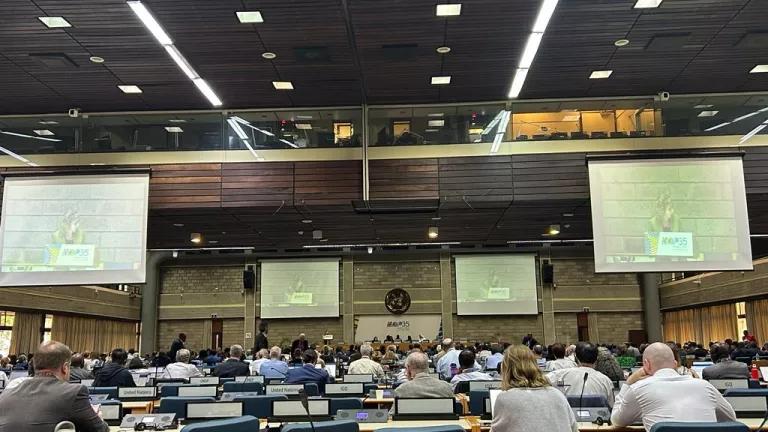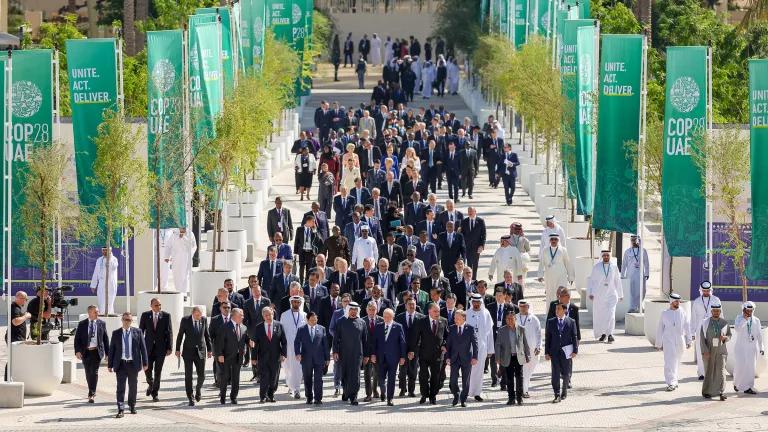Countries Agree on a Nearly Billion-Dollar HFC Phasedown Fund
Countries commit to nearly 1 billion dollars under the Montreal Protocol for programs to cut ozone-depleting and climate-warming substances in developing countries.

Countries at the 35th Meeting of the Parties to the Montreal Protocol in Nairobi, Kenya, on October 2023
Prima Madan/NRDC
Co-authored with Richie Kaur, Advocate, Non-CO2 Climate Pollution Reduction, Climate & Clean Energy Program, NRDC
Countries took big steps to protect the ozone layer and the climate at the 35th annual Meeting of the Parties to the Montreal Protocol (MOP)—the treaty that includes every nation on earth—in Nairobi, Kenya, late last month. They agreed on a record amount of $965 million in funding for developing country actions in 2024–2026, as well as additional studies on various topics, such as hydrofluorocarbon-23 (HFC-23) emissions, lifecycle refrigerant management (LRM), and geoengineering technologies like stratospheric aerosol injections; also discussed were further assessments of concerning chemicals and the advantages of improving energy efficiency while phasing down HFCs.
A primary reason for the Montreal Protocol’s success is the Multilateral Fund (MLF), through which developed countries provide financial assistance to developing countries to help them cut their reliance on ozone-depleting and climate-warming chemicals controlled under the treaty. NRDC and its partners pushed for the billion-dollar commitment—the highest level in MLF’s history. It comes at an important moment when developing countries plan to continue phasing out ozone-depleting substances and to start phasing down highly climate-warming HFCs to more than 80 billion tons of CO2 over the next 35 years, which is expected to avoid up to 0.5 degree Celsius of global temperature rise by the end of the century.
Other notable meeting updates
LRM: While the Kigali Amendment will cut new HFC production and import, it is also critical to keep the existing HFCs that are already in use from escaping into the atmosphere. As a result of advocacy by NRDC and its NGO partners—including this eye-opening report—countries agreed to a heightened focus on LRM. This includes more than recovery of HFCs when equipment is scrapped. It includes leak reduction, refrigerant recovery, recycling, reclamation, and destruction. Expert panels at MOP were tasked with assessing the challenges and opportunities for robust LRM practices, including examining the availability and accessibility of LRM equipment and facilities in developing countries. There will be a workshop on LRM at the next MOP in October 2024 in Bangkok. In addition, a strong MLF replenishment will support LRM implementation, should countries decide on it in future meetings.
The worst HFC: HFC-23 is one of the most potent greenhouse gases (GHGs) ever created. In global warming terms, one pound of HFC-23 traps as much heat as nearly 15,000 pounds of CO2 over 100 years. Today, HFC-23 is generated primarily as a by-product of making other chemicals. At the meeting, scientists raised concerns over a gap between countries’ reported emissions data and the amounts of HFC-23 measured in the atmosphere. Going forward, there will be increased scrutiny through the scientific and technical assessment panels, which will provide an update on the gap and look more closely at HFC-23 by country and by sector.
Scientific outlook: The scientific and technical assessment panels of MOP have a lot on their plate in the coming years. As mentioned, countries tasked the panels with evaluating LRM and HFC-23 issues. In addition, countries asked for more information on the risks and benefits of solar radiation management techniques like injecting aerosols into the stratosphere (which some propose as a means of limiting warming) and for additional assessments of various concerning chemicals, such as the highly persistent per- and polyfluoroalkyl substances (PFAS) as well as very short-lived substances like dichloromethane. Progress reports will be due at the next midyear meeting, scheduled to be held in Montreal in July 2024.
Energy efficiency: There is growing recognition that tackling both refrigerant (direct) and energy-related (indirect) GHG emissions simultaneously delivers the best bang for the climate buck. The meeting this year held a workshop on promoting the transition to energy-efficient and low- or zero–global warming potential technologies. The Montreal Protocol is currently set to invest $20 million in pilot energy efficiency projects and gain learnings. With the historic replenishment, there will be greater opportunities to dedicate more funding to boost energy efficiency while also phasing down HFCs. More concrete decisions on energy efficiency are expected in the upcoming meeting of the Executive Committee of the MLF in December 2023.
India side event: NRDC and its partners (Alliance for an Energy Efficient Economy and the Energy and Resources Institute) also hosted a side event on current best practices and market needs for implementing the Kigali Amendment in India. We discussed current refrigerant use patterns and preparations that are required for India to transition out of HFCs in various sectors. There was a robust discussion on transitioning the cold chain and air-conditioning sectors, LRM, and more.
With the ozone layer on the mend, the focus is shifting toward phasing down HFCs, LRM, and the co-benefits of addressing HFC emissions and energy efficiency simultaneously. The Montreal Protocol, the world’s most successful environmental treaty, continues to forge ahead!





